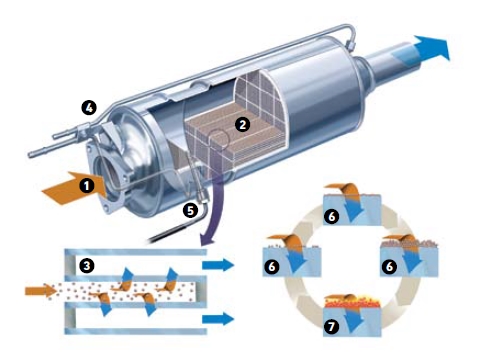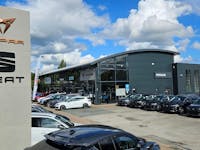Please Wait
This won't take a moment...
If you follow an old diesel vehicle that's accelerating away, you know what’ll happen – a small black cloud of soot will puff out of the exhaust. That'll soon be a thing of the past though because, thanks to their new DPF technology, modern diesel vehicles are cleaner than ever before.
The DPF is a filtration system, located within the exhaust system, which filters out harmful soot particles from the exhaust gases. The maintenance-free filter normally consists of a silicon carbide core, perforated by microscopic channels. The exhaust gas passes through the channel walls, on which the particulates collect.
No, the DPF is entirely self-cleaning, a process which is controlled by the engine management system and pressure and temperature sensors which detect when the filter must be cleaned.
The exhaust temperature is then increased by deliberate multiple fuel injections into the engine, raising the temperature of the DPF to 600°C, which burns the soot particles without leaving any residue.
The regeneration process takes place periodically, under normal driving conditions, without the driver noticing that it’s in progress. Vehicles that spend much of their time on short trips or in urban environments may require a longer journey at higher speeds to complete the regeneration cycle – in these instances a dashboard reminder light will inform the driver when this is required.
If the driver ignores the warning light and waits too long to operate the vehicle at a higher speed over a longer distance, the DPF may not regenerate properly. If this continues it can damage the DPF completely, meaning it will need to be replaced at an authorised garage.
If you think the Diesel Particulate Filter in your vehicle is damaged and needs replacing visit or call your nearest Pentagon Service Centre for advice.
 Upon entering the DPF (1) the exhaust gases are directed through the silicon carbide core (2) before being allowed to continue through the exhaust system.
Upon entering the DPF (1) the exhaust gases are directed through the silicon carbide core (2) before being allowed to continue through the exhaust system.
The construction of the core (3) offers a large surface area to the passing exhaust gases, giving a plentiful storage volume for collected soot.
The soot volumes are monitored at all times by pressure and temperature sensors (4/5), which feed information to the engine management system to determine when the filter requires regeneration.
When the soot levels (6) have reached their allowed limit, the regeneration process is initiated (7), in which the exhaust gas temperature is raised to 600°C, by multiple fuel injections, in order to burn off the soot particles.
Chester, Flintshire, CH5 2QJ
Derby, Derbyshire, DE22 4NB
Glasgow, Lanarkshire, G51 4SX
Gloucester, Gloucestershire, GL2 5FD
Manchester, Lancashire, M24 1SW
Wrexham, Wrexham, LL14 4DP
Grimsby, North East Lincolnshire, DN31 2TG
Halesowen, West Midlands, B63 2RL
Glasgow, Lanarkshire, G51 4SX
Derby, Derbyshire, DE22 4NB
Glasgow, Lanarkshire, G51 4SX
Sandycroft, Deeside, CH5 2QE
Manchester, Greater Manchester, M17 1HG
Lincoln, Lincolnshire, LN6 7QY
 Pentagon Citroen Lincoln
Pentagon Citroen Lincoln
Lincoln, Lincolnshire, LN6 7QY
 Pentagon Citroen Loughborough
Pentagon Citroen Loughborough
Loughborough, Leicestershire, LE11 1NE
 Pentagon CUPRA Huddersfield
Pentagon CUPRA Huddersfield
Huddersfield, West Yorkshire, HD2 1AA
Lincoln, Lincolnshire, LN6 7QY
Rochdale, Lancashire, OL11 1TQ
 Pentagon Ford Runcorn
Pentagon Ford Runcorn
Runcorn, Cheshire, WA7 2XP
 Pentagon Ford St. Helens
Pentagon Ford St. Helens
St. Helens, Merseyside, WA9 5AD
 Pentagon Ford Warrington
Pentagon Ford Warrington
Warrington, Cheshire, WA2 7NY
 Pentagon Kia Sheffield
Pentagon Kia Sheffield
Sheffield, South Yorkshire, S9 4WA
 Pentagon Mazda Lincoln
Pentagon Mazda Lincoln
Lincoln, Lincolnshire, LN6 7QY
Lincoln, Lincolnshire, LN6 7QY
 Pentagon Nissan Barnsley
Pentagon Nissan Barnsley
Barnsley, South Yorkshire, S75 1LR
 Pentagon Peugeot Barnsley
Pentagon Peugeot Barnsley
Barnsley, South Yorkshire, S75 1LR
 Pentagon Peugeot Burton Upon Trent
Pentagon Peugeot Burton Upon Trent
Burton-on-Trent, Staffordshire, DE13 0DF
 Pentagon Peugeot Lincoln
Pentagon Peugeot Lincoln
Lincoln, Lincolnshire, LN6 7QY
 Pentagon Peugeot Loughborough
Pentagon Peugeot Loughborough
Loughborough, Leicestershire, LE11 1NE
 Pentagon Peugeot Scunthorpe
Pentagon Peugeot Scunthorpe
Scunthorpe, North Lincolnshire, DN16 3RL
Lincoln, Lincolnshire, LN6 7QY
 Pentagon Renault Loughborough
Pentagon Renault Loughborough
Loughborough, Leicestershire, LE11 1NE
 Pentagon Renault Rochdale
Pentagon Renault Rochdale
Rochdale, Lancashire, OL11 1TQ
 Pentagon SEAT Huddersfield
Pentagon SEAT Huddersfield
Huddersfield, West Yorkshire, HD2 1AA
 Pentagon SEAT Nottingham - Chilwell
Pentagon SEAT Nottingham - Chilwell
Nottingham, Nottinghamshire, NG9 4AJ
 Pentagon SEAT Oldham - Park Road
Pentagon SEAT Oldham - Park Road
Oldham, Lancashire, OL8 1DB
 Pentagon SEAT Scunthorpe
Pentagon SEAT Scunthorpe
Scunthorpe, North Lincolnshire, DN16 3RL
 Pentagon Vauxhall Burton Upon Trent
Pentagon Vauxhall Burton Upon Trent
Burton-on-Trent, Staffordshire, DE13 0DF
 Pentagon Vauxhall Derby
Pentagon Vauxhall Derby
Derby, Derbyshire, DE21 6HB
 Pentagon Vauxhall Loughborough
Pentagon Vauxhall Loughborough
Loughborough, Leicestershire, LE11 1NE
 Pentagon Vauxhall Middleton
Pentagon Vauxhall Middleton
Manchester, Lancashire, M24 1SW
 Pentagon Vauxhall Oldham - Chadderton Way
Pentagon Vauxhall Oldham - Chadderton Way
Oldham, Lancashire, OL1 2QL
 Pentagon Vauxhall Rochdale
Pentagon Vauxhall Rochdale
Rochdale, Lancashire, OL11 1TQ
 Pentagon Vauxhall Sheffield
Pentagon Vauxhall Sheffield
Sheffield, South Yorkshire, S9 4WA
Derby, Derbyshire, DE22 4NB
Stoke-on-Trent, Staffordshire, ST6 2DE
Glasgow, Lanarkshire, G51 4SX
Nottingham, Nottinghamshire, NG9 2JR
This won't take a moment...
If you have a query relating to Discretionary Commission Agreements please email customer.care@pentagon-group.co.uk However, please note that if your query related to a purchase more that 7 years ago we will no longer hold any details due to our data retention policy.
Due to unforseen circumstances, our Pentagon Middleton site on Greeside Way currently has no power. We apologise for any inconvenience.
This won't take a moment...